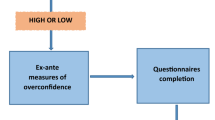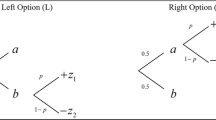Abstract
Most decisions concerning (self-)insurance and self-protection have to be taken in situations in which (a) the effort exerted precedes the moment uncertainty realizes, and (b) the probabilities of future states of the world are not perfectly known. By integrating these two characteristics in a simple theoretical framework, this paper derives plausible conditions under which ambiguity aversion raises the demand for (self-)insurance and self-protection. In particular, it is shown that in most usual situations where the level of ambiguity does not increase with the level of effort, a simple condition of ambiguity prudence known as decreasing absolute ambiguity aversion (DAAA) is sufficient to give a clear and positive answer to the question: Does ambiguity aversion raise the optimal level of effort?

Similar content being viewed by others
Notes
Adaptation is the “process of adjustment to actual or expected climate and its effects. In human systems, adaptation seeks to moderate harm or exploit beneficial opportunities” (IPCC 2014a).
Mitigation is a “human intervention to reduce the sources or enhance the sinks of greenhouse gases”(IPCC 2014b).
This means that the probability distributions are assumed to be known with certainty. In particular, those models implicitly assume the absence of any kind of ambiguity, or equivalently, assume that agents are ambiguity neutral [and, therefore, behave as subjective expected utility maximizers in the sense of Savage (1954)]. Notably exceptions to this are the recent papers by Etner and Spaeter (2010), Snow (2011) and Alary et al. (2013).
As first shown by Ellsberg (1961) and later confirmed by a number of experimental studies (see Trautmann and van de Kuilen 2013 for a survey of this literature), the uncertainty on the probabilities of a random event (called ambiguity) often leads the decision maker to violate expected utility in the sense that it makes him overevaluate the likelihood of the less desirable outcomes.
Imagine for example that doing sport enables to lower recovery costs, thanks to a better physical condition.
Depending on the value of some parameters such as the blood pressure, cholesterol, etc. different institutes will estimate the probability of heart disease very differently, as is illustrated in Gilboa and Marinacci (2011). For what concerns the probability of suffering from a given loss, conditional of heart disease, think for example to the case in which a treatment consisting in surgical operation is available, but with a success rate that is unknown.
While many different models to deal with ambiguity exist in the literature (see Etner et al. 2012 for an excellent survey of these models), I choose to use the KMM model in this paper because it naturally defines the notion of ambiguity neutrality, and because the smoothness of the ambiguity function enables to use the well-developed machinery of the expected utility sequentially.
See also Etner and Spaeter (2010) for an application of these models in the field of health economics.
Imagine that parameter \(\theta \) can take values \(\theta _1,\theta _2,\ldots ,\theta _n\) with probabilities \([q_1,q_2,\ldots ,q_n]\), such that the expectation with respect to the parametric uncertainty is written \(\mathrm {E}_\theta g(\tilde{\theta })=\sum _{j=1}^n q_j g(\theta _j)\).
In what follows, I assume that \(\beta =1\), an assumption that has no impact on the results obtained.
Notice that for simplicity, I assume that \(\phi \) is only defined for non-negative values. Any value inside the second bracket must, therefore, be non-negative, which should not be a problem since any positive affine transformation of u represents the same preferences over risky situations. KMM consider for example the unique continuous, strictly increasing function u with \(u(0)=0\) and \(u(1)=1\) that represents any given preferences.
Berger (2011) defines the uncertainty premium as the combination of both the risk and the ambiguity premia.
Alternatively in the sport example, ambiguity is said to be concentrated on the bad states of the world if the probability of developing heart disease is known, but the probability of success for heart surgery is unknown.
Two random variables X and Y, that are strictly monotonic transformations of a single random variable \(\theta \): \((X,Y)=(f(\theta ),g(\theta ))\), are said to be anti-comonotonic if f is increasing and g is decreasing in \(\theta \), and comonotonic if f and g are both increasing or decreasing in \(\theta \).
Note that the condition \(\epsilon \in [p(\theta )-1,p(\theta )]\) is implicitly assumed for all \(\theta \), in order to guarantee that the probability of being in the bad state belongs to the interval [0, 1].
Remember that \(\beta \) is fixed to unity for simplicity and without altering the final comparative statics results. It should, however, be understood that the higher is the pure rate of time preference (and hence the lower is the discount factor \(\beta \)), the lower is the desire to invest any effort in preventive action if its cost has to be borne in advance.
In the climate change example, the IPCC (2007) report note that the desirability of preventive efforts is measured not only by the reduction in the expected (average) damages, but also by the value of the reduced uncertainties that such efforts yield.
Remember that according to Klibanoff et al. (2005), constant ambiguity attitude is characterized either by linear or exponential function \(\phi \).
Note that in this example, p(e) is the loss probability law considered by an ambiguity neutral agent and that the ambiguity averse DM associates the same prior belief to each value of \(\theta \), in such a way that \(\theta _2=-\theta _1\) in the additive case, and \(\theta _2=2-\theta _1\) in the multiplicative case.
The proof is adapted from Gierlinger and Gollier (2008).
References
Alary, D., Gollier, C., & Treich, N. (2013). The effect of ambiguity aversion on insurance and self-protection. The Economic Journal, 123, 1188–1202.
Berger, L. (2011). Smooth ambiguity aversion in the small and in the large. Working Papers ECARES 2011-020, ULB—Université libre de Bruxelles.
Berger, L. (2014). Precautionary saving and the notion of ambiguity prudence. Economics Letters, 123(2), 248–251.
Courbage, C., Rey, B., & Treich, N. (2013). Prevention and precaution. In Handbook of insurance, pp. 185–204. Springer.
Eeckhoudt, L., & Gollier, C. (2005). The impact of prudence on optimal prevention. Economic Theory, 26(4), 989–994.
Ehrlich, I., & Becker, G. (1972). Market insurance, self-insurance, and self-protection. The Journal of Political Economy, 80(4), 623–648.
Ellsberg, D. (1961). Risk, ambiguity, and the Savage axioms. The Quarterly Journal of Economics, 75, 643–669.
Etner, J., Jeleva, M., & Tallon, J.-M. (2012). Decision theory under ambiguity. Journal of Economic Surveys, 26(2), 234–270.
Etner, J., & Spaeter, S. (2010). The impact of ambiguity on health prevention and insurance. Working Papers of BETA 2010-08, Bureau d’Economie Théorique et Appliquée, UDS, Strasbourg.
Gierlinger, J. & Gollier, C. (2008). Socially efficient discounting under ambiguity aversion. Working Paper.
Gilboa, I. & Marinacci, M. (2011). Ambiguity and the bayesian paradigm. In Advances in economics and econometrics, tenth world congress, Volume 1.
Gilboa, I., & Schmeidler, D. (1989). Maxmin expected utility with a non-unique prior. Journal of Mathematical Economics, 18(2), 141–154.
Gollier, C. (2001). The Economics of Risk and Time. The MIT Press, Cambridge.
IPCC (2007). Framing Issues. In Climate Change 2007: Mitigation. Contribution of Working Group III to the Fourth Assessment Report of the Intergovernmental Panel on Climate Change [B. Metz, O. R. Davidson, P. R. Bosch, R. Dave, L. A. Meyer (Eds.)] Cambridge University PressCambridge University Press, Cambridge, United Kingdom and New York, NY, USA.
IPCC (2014a). Climate Change 2014: Impacts, Adaptation, and Vulnerability. Part A: Global and Sectoral Aspects. Contribution of Working Group II to the Fifth Assessment Report of the Intergovernmental Panel on Climate Change. [Field, C. B. and Barros, V. R. and Dokken, D. J. and Mach, K. J. and Mastrandrea, M. D. and Bilir, T. E. and Chatterjee, M., and Ebi, KL and Estrada, YO and Genova, RC and others]. Cambridge, UK/New York, NY: Cambridge University Press.
IPCC (2014b). Climate Change 2014, Mitigation of Climate Change. Contribution of Working Group III to the Fifth Assessment Report of the Intergovernmental Panel on Climate Change. Summary for Policymakers. Working Group III to the Fifth Assessment Report of the Intergovernmental Panel on Climate Change [Edenhofer, O., R. Pichs-Madruga, Y. Sokona, E. Farahani, S. Kadner, K. Seyboth, A. Adler, I. Baum, S. Brunner, P. Eickemeier, B. Kriemann, J. Savolainen, S. Schlmer, C. von Stechow, T. Zwickel and J. C. Minx (Eds.)]. Cambridge University Press, Cambridge, United Kingdom and New York, NY, USA.
Klibanoff, P., Marinacci, M., & Mukerji, S. (2005). A smooth model of decision making under ambiguity. Econometrica, 73, 1849–1892.
Klibanoff, P., Marinacci, M., & Mukerji, S. (2009). Recursive smooth ambiguity preferences. Journal of Economic Theory, 144(3), 930–976.
Kreps, D., & Porteus, E. (1978). Temporal resolution of uncertainty and dynamic choice theory. Econometrica, 46(1), 185–200.
Maccheroni, F., Marinacci, M., & Ruffino, D. (2013). Alpha as ambiguity: Robust mean-variance portfolio analysis. Econometrica, 81(3), 1075–1113.
Menegatti, M. (2009). Optimal prevention and prudence in a two-period model. Mathematical Social Sciences, 58(3), 393–397.
Meyer, D. J., & Meyer, J. (2011). A diamond-stiglitz approach to the demand for self-protection. Journal of Risk and Uncertainty, 42(1), 45–60.
Savage, L. (1954). The Foundations of Statistics (p. 1972). New York: J. Wiley. second revised edition.
Selden, L. (1978). A new representation of preferences over “certain x uncertain” consumption pairs: The “ordinal certainty equivalent” hypothesis. Econometrica, 46(5), 1045–1060.
Snow, A. (2011). Ambiguity aversion and the propensities for self-insurance and self-protection. Journal of Risk and Uncertainty, 42, 27–43.
Trautmann, S., & van de Kuilen, G. (2013). Ambiguity attitudes. Prepared for the Blackwell Handbook of Judgment and Decision Making, edited by Gideon Keren and George Wu, Tilburg University.
Acknowledgments
The author thanks David Alary, Louis Eeckhoudt, Renaud Foucart, Christian Gollier, François Salanié, Nicolas Treich, and Philippe Weil for helpful comments and discussions. The research leading to this paper received funding from the FRS-FNRS and from the European Union Seventh Framework Programme FP7/2007-2013 under Grant agreement no. 308329 (ADVANCE).
Author information
Authors and Affiliations
Corresponding author
Appendix
Appendix
Proof of Proposition 4
This proof is based on the following Lemma, that can be found in Gollier (2001).Footnote 21
Lemma 2
Let \(\phi \) be a twice differentiable, increasing and concave function: \(\mathbb {R} \rightarrow \mathbb {R}\). Consider a probability vector \((q_1,\ldots , q_n) \in \mathbb {R}^n_+\) with \(\sum _{\theta =1}^n q_\theta =1\), and a function \(f: \mathbb {R}^n \rightarrow \mathbb {R}\), defined as
Let T be the function such that \(T(U)=-\frac{\phi '\{U\}}{\phi ''\{U\}}\). Function f is concave in \(\mathbb {R}^n\) if and only if T is weakly concave in \(\mathbb {R}\).
First, remark that programme (10) is convex if
is concave in e.
The proof is given in the case where ambiguity is concentrated on the type of states. The two other cases follow trivially.
Self-insurance \((p(e,\theta )=p(\theta )\) for all levels of e): consider two scalars \(e_1\) and \(e_2\), and let \(U_{j\theta }\) denote the second period expected utility conditional on \(\theta \), for a level of effort \(e_j: U_{j\theta }=p(\theta )\mathrm {E}u({\tilde{w}}_{2}^b(e_j)) +\left[ 1-p(\theta )\right] \mathrm {E} u({\tilde{w}}_{2}^g)\). Under the notations above, \(V(e_j)=f(U_{j1},\ldots ,U_{jn})\). Then, under concavity of u and \(w_{2}^b\), and for any \((\lambda _1,\lambda _2)\in \mathbb {R}^2_+\) such that \(\lambda _1+\lambda _2=1\), we have:
Multiplying the first and the third parts of this chain of inequalities by \(p(\theta )\) and adding \(\left[ 1-p(\theta )\right] \mathrm {E}u({\tilde{w}}_2^g)\) yields:
for all \(\theta \), where \(e_\lambda =\lambda _1 e_1+\lambda _2 e_2\). Because f is increasing in \(\mathbb {R}^n\) if \(\phi \) is increasing, this implies:
On the other side, if \(-\phi '/\phi ''\) is concave, by Lemma 2 we have:
Combining these two results yields \(V(\lambda _1 e_1+\lambda _2 e_2)\ge \lambda _1 V(e_1)+\lambda _2 V(e_2)\) implying that V is concave in e.
Self-protection \((w_{2}^b(e)=w_{2}^b\) for all levels of e): in this case, the proof is similar but \(U_{j\theta }\) is now given by \(U_{j\theta }=p(e_j,\theta )\mathrm {E} u({\tilde{w}}_{2}^b)+\left[ 1-p(e_j,\theta )\right] \mathrm {E} u({\tilde{w}}_{2}^g)\), and we exploit the convexity of \(p(e,\theta )\) in e to obtain \(\lambda _1 U_{1\theta }+\lambda _2 U_{2\theta }\le U_{\lambda \theta }\). \(\square \)
Proof of Proposition 7
-
1.
Imagine that the set of risky second period wealth in the bad states of the world can be ranked according to FSD:
$$\begin{aligned} {\tilde{w}}_2^b(e^*,\theta _1) \succeq _{FSD}\dots \succeq _{FSD}{\tilde{w}}_2^b(e^*,\theta _n). \end{aligned}$$(14)From the definition of FSD, this is the case if and only if for every function f weakly increasing, we have:
$$\begin{aligned} \mathrm {E} f({\tilde{w}}_2^b(e^*,\theta _1))\ge \dots \ge \mathrm {E} f({\tilde{w}}_2^b(e^*,\theta _n)). \end{aligned}$$(15)Given that \(u'>0\), it is, therefore, clear that \(U(e^*,\theta )=p\mathrm {E} u({\tilde{w}}_2^b(e^*,\theta ))+(1-p) \mathrm {E} u({\tilde{w}}_2^g)\) is decreasing in \(\theta \), and that \(U_e(e^*,\theta )=\mathrm {E} g({\tilde{w}}_2^b(e^*,\theta ))\) will be increasing in \(\theta \) if and only if g is decreasing. Now remark that this will be the case if, by ordering (without loss of generality) the different bad states such that \(w_{2,s}^b\ge w_{2,s+1}^b\), we have:
$$\begin{aligned} g(w_{2,s}^b(e^*,\theta ))= & {} u'(w_{2,s}^b(e^*,\theta ))\frac{\partial w_{2,s}^b(e^*,\theta )}{\partial e}\nonumber \\\le & {} u'(w_{2,s+1}^b(e^*,\theta ))\frac{\partial w_{2,s+1}^b(e^*,\theta )}{\partial e}=g(w_{2,s+1}^b(e^*,\theta ))\quad \quad \quad \end{aligned}$$(16)for all \(\theta \), and all s. It is then easy to see that inequality (16) will be satisfied if \(u''\le 0\) and \(\frac{\partial w_{2,s}^b(e^*,\theta )}{\partial e}\le \frac{\partial w_{2,s+1}^b(e^*,\theta )}{\partial e}\), meaning that the marginal benefit of self-insurance is higher for higher losses.
-
2.
Imagine that the set of risky second period wealth in the bad states of the world can be ranked according to SSD:
$$\begin{aligned} {\tilde{w}}_2^b(e^*,\theta _1) \succeq _{SSD}\cdots \succeq _{SSD}{\tilde{w}}_2^b(e^*,\theta _n). \end{aligned}$$(17)From the definition of SSD, this is the case if and only if for every non-decreasing, concave function f, we have:
$$\begin{aligned} \mathrm {E} f({\tilde{w}}_2^b(e^*,\theta _1))\ge \cdots \ge \mathrm {E} f({\tilde{w}}_2^b(e^*,\theta _n)). \end{aligned}$$(18)Given that \(u'>0\) and \(u''>0\) under risk aversion, we know that \(U(e^*,\theta )=p\mathrm {E} u({\tilde{w}}_2^b(e^*,\theta ))+(1-p) \mathrm {E} u({\tilde{w}}_2^g)\) is decreasing in \(\theta \). Similarly, \(U_e(e^*,\theta )=\mathrm {E} g({\tilde{w}}_2^b(e^*,\theta ))\) will be increasing in \(\theta \) if and only if \(g'\le 0\) and \(g''>0\). Since we know that \(g(w_{2,s}^b(e^*,\theta ))= u'(w_{2,s}^b(e^*,\theta ))\frac{\partial w_{2,s}^b(e^*,\theta )}{\partial e}\), this will be the case if
$$\begin{aligned}&u'\big (\lambda w_{2,i}^b(e^*,\theta )+(1-\lambda ) w_{2,j}^b(e^*,\theta )\big ) \Bigg [ \lambda \frac{\partial w_{2,i}^b(e^*,\theta )}{\partial e} +(1-\lambda ) \frac{\partial w_{2,j}^b(e^*,\theta )}{\partial e}\Bigg ]\nonumber \\&\quad \le \lambda \Bigg [ u'(w_{2,i}^b(e^*,\theta ))\frac{\partial w_{2,i}^b(e^*,\theta )}{\partial e}\Bigg ]+ (1-\lambda ) \Bigg [ u'(w_{2,j}^b(e^*,\theta ))\frac{\partial w_{2,j}^b(e^*,\theta )}{\partial e}\Bigg ]\nonumber \\ \end{aligned}$$(19)for all \(\theta \), all \(i,j\in s\), and all \(\lambda \in [0,1]\). It is then easy to see that inequality (19) is satisfied with an equality if \(u''= 0\), and with a strict inequality if \(\frac{\partial w_{2,i}^b(e^*,\theta )}{\partial e}= \frac{\partial w_{2,j}^b(e^*,\theta )}{\partial e}\) and the agents exhibits risk prudence: \(u'''>0\). More generally, the risk prudence property implies that:
$$\begin{aligned} u'\big (\lambda w_{2,i}^b(e^*,\theta )+(1-\lambda ) w_{2,j}^b(e^*,\theta )\big )\le \lambda u'\big (w_{2,i}^b(e^*,\theta )\big ) + (1-\lambda ) u'\big (w_{2,j}^b(e^*,\theta )\big ), \end{aligned}$$(20)and it is, therefore, possible to form a chain of inequalities with expressions (19) and (20) to show that g is convex if
$$\begin{aligned}&u'(w_{2,i}^b(e^*,\theta )) \Bigg [ \frac{\partial w_{2,i}^b(e^*,\theta )}{\partial e} - \frac{\partial w_{2,j}^b(e^*,\theta )}{\partial e} \Bigg ]\nonumber \\&\quad \ge u'(w_{2,j}^b(e^*,\theta )) \Bigg [ \frac{\partial w_{2,i}^b(e^*,\theta )}{\partial e} - \frac{\partial w_{2,j}^b(e^*,\theta )}{\partial e} \Bigg ]. \end{aligned}$$(21)A sufficient condition for this expression to be satisfied is, therefore, that \(\frac{\partial w_{2,i}^b(e^*,\theta )}{\partial e}\ge \frac{\partial w_{2,j}^b(e^*,\theta )}{\partial e}\) whenever \(w_{2,i}^b(e^*,\theta )\le w_{2,j}^b(e^*,\theta )\), and vice versa.
\(\square \)
Rights and permissions
About this article
Cite this article
Berger, L. The impact of ambiguity and prudence on prevention decisions. Theory Decis 80, 389–409 (2016). https://doi.org/10.1007/s11238-015-9512-1
Published:
Issue Date:
DOI: https://doi.org/10.1007/s11238-015-9512-1




